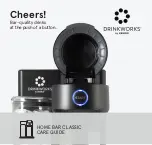
To order parts and supplies: 800.343.9353 >> eastwood.com
19
ARC RAYS CAN BURN!
•
Arc rays produce intense ultraviolet radiation which can burn exposed skin and cause eye damage. Use a shield with the proper
filter (a minimum of #11) to protect your eyes from sparks and the rays of the arc when welding or when observing open arc
welding (see ANSI Z49.1 and Z87.1 for safety standards).
•
Use suitable clothing made from durable flame-resistant material to protect your skin.
•
If other persons or pets are in the area of welding, use welding screens to protect bystanders from sparks and arc rays.
FUMES AND WELDING GASES CAN BE A HEALTH HAZARD!
•
Fumes and gasses released during welding are hazardous. Do not breathe fumes that are produced by the welding operation. Wear
an OSHA-approved respirator when welding.
•
Always work in a properly ventilated area.
•
Never weld coated materials including but not limited to: cadmium plated, galvanized, lead based paints.
HOT METAL AND TOOLS WILL BURN!
•
Electric welding heats metal and tools to temperatures that will cause severe burns!
•
Use protective, heat resistant gloves and clothing when using Eastwood or any other welding equipment. Never touch welded work
surface, torch tip or nozzle until they have completely cooled.
FLYING METAL CHIPS CAN CAUSE INJURY!
•
Grinding and sanding will eject metal chips, dust, debris and sparks at high velocity. To prevent eye injury wear approved safety
glasses.
•
Wear an OSHA-approved respirator when grinding or sanding.
•
Read all manuals included with specific grinders, sanders or other power tools used before and after the welding process. Be aware
of all power tool safety warnings.
INADEQUATE WIRING CAN CAUSE FIRE AND INJURY!
•
Verify that the facility power source has properly rated wiring to handle power requirements of this Welder.
STICK WELDING PROCEDURE
• Set up a clean will lit work area.
• Prepare the parts to be welded by cleaning the weld joint area of any rust, dirt, grease, or paint.
• Select the proper electrode for the weld joint.
• Turn on the Welder and select the appropriate amperage. To determine proper amperage it is best to practice on some similar metals to set up the machine
before welding on an actual part of value.
• Attach the ground clamp to a clean bare metal section on the work piece.
• Insert the electrode into the electrode holder being careful not to allow the electrode to contact the grounded area.
• To start welding an arc must be struck, to do this a motion similar to striking a match will have to be performed with the electrode. Slowly bring the
electrode closer to the weld joint and then contact and drag the electrode across the piece to strike the arc. Once the arc has been stuck you can continue
feeding the electrode into the weld joint.
• While moving along the weld joint the electrode will burn down, while it is burning you will need to continue moving the electrode closer to the joint trying
to keep a 1/8” gap between the end of the electrode and the weld joint. The electrode holder must be held so that the electrode is in a downward angle
moving in the direction of the weld joint.
• To stop welding simply lift the electrode away from the work piece. When finished welding remove the electrode from the holder and turn off the Welder.














































